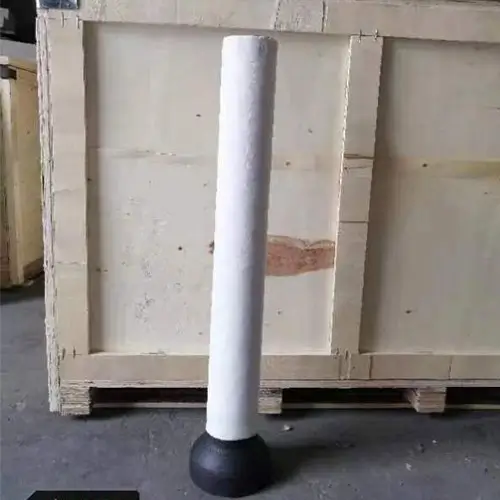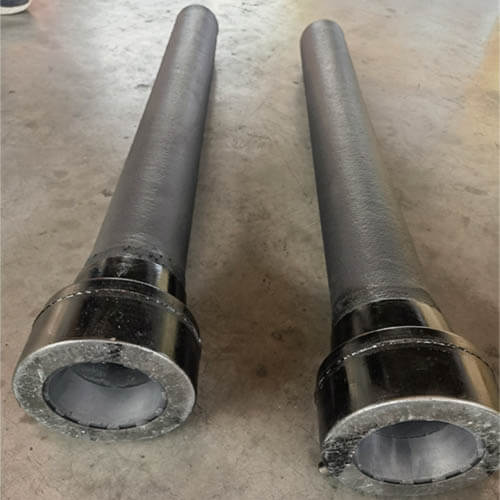Currently, nearly 80% of the world’s steel billets are produced using continuous casting technology. Long nozzles, stoppers, and submerged nozzles are key refractory materials for achieving high-reliability continuous casting, and their performance directly impacts continuous casting efficiency and billet quality. With the development of modern high-speed, high-efficiency continuous casting technology and clean steelmaking technologies, the performance of existing functional refractories for continuous casting must be further improved, and new materials must be developed. Functional refractories for continuous casting are developing towards high performance, multi-functions, and long life. This article discusses some key properties of functional refractories for continuous casting, measures to improve their service life, and recent development trends.
The performance and use of submerged nozzles directly impact continuous casting efficiency and ingot quality. During use, they must be resistant to corrosion from molten steel and mold slag, and must not react with the molten steel to form blockages. Initially, submerged nozzles were made of fused quartz, but this material exhibited poor corrosion resistance and could not meet the requirements of multi-furnace continuous casting and clean steel production. Currently, composite submerged nozzles are primarily used, with the main body made of Al2O3-C and the slag line composited with ZrO2-C. While ensuring thermal shock resistance, the slag line’s resistance to mold slag corrosion and the nozzle’s ability to resist Al2O3 nodules are key factors in determining a submerged nozzle’s service life.
1.Alumina blockage and its prevention measures
When casting certain specialty steels and Al- or Al-Si-killed steels, Al2O3-C or Al2O3-ZrO2-C submerged nozzles often produce Al2O3 nodules. This can cause unstable molten steel flow and even nozzle blockage, disrupting normal casting flow and affecting billet quality. This has become a major obstacle to achieving multi-furnace continuous casting and improving continuous casting efficiency using Al2O3-C or Al2O3-ZrO2-C submerged nozzles. Possible causes of alumina nodules on the nozzle wall include:
First, deoxidation of the molten steel produces Al2O3;
Second, the SiO2 and carbon contained in the refractory material promote the formation of Al2O3. The reaction is as follows:
SiO2(s)+C(s)=SiO(g)+CO(g)
3SiO(g)+2Al(l)=Al2O3(s)+3Si(l)
3CO(g)+2Al(l)=Al2O3(s)+3C(s)
Third, Al2O3 particles contact, adhere, and grow on the inner wall of the submerged nozzle under the action of the surface tension of alumina and molten steel. To reduce Al2O3 nodules, the following measures can be taken from a mechanistic point of view: lower the melting point of the deoxidation product Al2O3, for example, by treating the molten steel with Ca to transform Al2O3 into a low-melting-point substance of the Al2O3-CaO system; use degassing technology to purify the molten steel; control the temperature of the molten steel to drop; change the nozzle lining material so that a certain component in it reacts with Al2O3 at high temperature, forming a low-melting-point phase at the interface between the molten steel and the refractory material, which is carried away by the molten steel and enters the slag. To eliminate Al2O3 deposition, for example, compounding the inner wall of the nozzle with a CaO-containing material or using silicon-free and carbon-free nozzle lining materials can fundamentally reduce Al2O3 formation.
Currently, research on submerged nozzles to prevent Al2O3 blockage focuses primarily on nozzle lining materials. Materials that have been developed include Sialon-ZrO2, CaO-MgO-Al2O3, ZrO2-ZrB2-C, BN-AlN-C, and ZrO2-CaO-C. Recently, silicon-free and carbon-free lining materials have also been developed. Based on the reaction between alumina and a component in the refractory material, the lining material is shaped like a silicon-free lining. Based on the principle of forming low-melting-point substances, the ZrO2-CaO-C material developed has been successfully applied in practice. However, it is difficult to determine the optimal CaO content in the lining material for preventing Al2O3 clogging for specific steel grades and casting conditions. Furthermore, as casting progresses, graphite oxidation often causes the inner working surface to become rough and uneven, making it difficult to achieve effective prevention of alumina clogging.
Japan recently developed and piloted a silicon- and carbon-free submerged nozzle lining material. Using a composite spinel material for the inner wall, actual machine casting tests demonstrated a significant reduction in Al2O3 nodules and a high internal surface area after casting. The wall’s working surface is smooth, and the material exhibits excellent thermal shock resistance. Because this material fundamentally reduces the source of alumina, it is a very promising lining material for preventing alumina clogging. This lining material is also more suitable for the smelting of clean steel and ultra-low carbon steel. Currently, my country has successfully developed ZrO2-CaO-C materials, which are successfully used by manufacturers such as Wuhan Iron and Steel Group and Tianjin Dafeng Steel. Research on silicon- and carbon-free lining materials is just beginning. To meet the needs of my country’s high-cleanliness steel smelting, the development of silicon- and carbon-free lining materials for submerged nozzles is of particular importance.
2.Corrosion resistance of slag line material
The erosion resistance of the slag line of submerged nozzles is another important factor affecting their lifespan. Currently, ZrO2-C is widely used in slag lines, offering significantly improved erosion resistance compared to the previous Al2O3-C material. Generally speaking, ZrO2-C with a carbon content of 15% exhibits the best overall performance.
The erosion mechanisms of ZrO2-C include: oxidation and dissolution of carbon by molten steel; and reaction and desolvation of the ZrO2 stabilizer, CaO, with corrosive components in the slag, such as SiO2 and Na2O, causing some of the stabilized zirconia to fracture and transform into fine monoclinic zirconia. The former leads to structural embrittlement of the ZrO2-C material, while the latter causes the formation of m-ZrO2 and glassy phases. The ZrO2-C material is generated and washed away into the slag by the oscillating motion of the cleaner. The corrosion resistance of ZrO2-C material faces even greater challenges when casting certain specialty steels or under certain casting processes. For example, when casting high-oxygen steel, when casting with a tundish or ladle is restricted, and when casting thin slabs, efficient multi-furnace continuous casting is impossible.
To further improve the corrosion resistance of the slag line material, considerations can be made regarding both the nozzle structure and the material composition. Based on the corrosion mechanism of ZrO2-C, reducing the carbon content in the ZrO2-C material may improve its corrosion resistance. However, this reduction in carbon content inevitably compromises thermal shock resistance. To address this issue, DiDier has developed a submerged nozzle with a three-layer structure for the slag line.
3.Submerged nozzle for thin slab continuous casting
Submerged nozzles are one of the three key components of thin slab continuous casting. Because thin slabs are cast very thinly, with a thickness of only 50-70 mm, the distance between the mold walls must be short. Consequently, the external dimensions of the submerged nozzle are strictly limited by the shape and size of the mold. To maintain the same productivity as conventional slab continuous casting, the nozzle cavity should be as large as possible. These factors necessitate a thin-walled nozzle design, typically with a wall thickness of 10-17.5 mm. However, the erosion resistance of the slag line, a key factor in determining nozzle life, is proportional to the thickness of the nozzle wall. This means that, using the same mold slag composition, the service life of thin slab continuous casting nozzles is shorter than that of conventional continuous casting submerged nozzles. Furthermore, due to the high mold vibration frequency, rapid steel flow rate within the nozzle, and the low viscosity and more corrosive mold slag in the thin slab continuous casting process, submerged nozzles face more severe challenges. The test of this is a challenge.
Therefore, to extend the service life of submerged nozzles for thin slab continuous casting, the nozzle material must possess excellent thermal shock resistance, high corrosion resistance, high hot strength, and excellent oxidation resistance. Furthermore, because the dimensions of submerged nozzles for thin slab continuous casting are limited by the shape of the mold, the structure is relatively complex, and structural stresses must be avoided during design and fabrication.
Due to the thin walls (15mm) of submerged nozzles, their service life is generally limited to three furnaces, severely restricting the continuous casting process and improving casting efficiency. Therefore, the development of new, high-performance submerged nozzle materials is needed. As my country’s steel industry moves towards high-efficiency continuous casting, thin slab continuous casting has experienced rapid development in my country in the past two years, but the submerged nozzles used are entirely imported. Therefore, research on submerged nozzles for thin slab continuous casting is a key topic in the field of continuous casting refractory materials, both in my country and globally.

4.Long Nozzle
The design of the shroud material is primarily based on the type of steel being cast, the casting time, and the type of tundish coating. Currently, Al2O3-C is the primary material used. This material is highly adaptable to various steel grades, particularly suitable for casting special steels, and minimizes molten steel contamination.
To meet the needs of efficient continuous casting, the optimal design composition can be tailored to the varying operating conditions of each shroud component to maximize its service life. The wrist is subject to wear and is prone to air ingestion, so low-SiO2 or SiO2-free Al2O3-C materials are typically used, or the graphite content can be appropriately reduced. Due to erosion by the tundish coating and molten steel, the slag line is often the primary factor affecting the shroud life. To improve the erosion resistance of the slag line, Depending on the type of steel being cast and the tundish coating, ZrO2-C or MgO-C can be used.
Currently, there are two main development directions for shrouds. One is the development of SiO2-free shrouds. Traditional Al2O3-C shrouds typically contain a certain amount of fused quartz to improve thermal shock resistance. However, SiO2 reacts with MnO or FeO to form low-melting-point substances, which reduces the material’s resistance to erosion and erosion. Therefore, SiO2-free Al2O3-C has been developed for casting high-manganese or high-oxygen steels. Compared to traditional Al2O3-C, this material has a relatively large thermal expansion coefficient, requiring precise control of preheating conditions.

